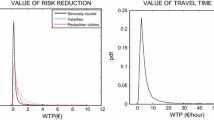Abstract
Technology and human behavior can influence the effectiveness of safety policies. In the field of traffic safety, rational-choice theorists postulate that automobile safety devices induce increased driver risk taking. Such behavioral responses could partly or totally nullify the lifesaving potential of governmental safety rules for new cars, such as the crashworthiness standards adopted by the United States in the late 1960s and early 1970s. This study explores the behavioral-response hypothesis in the context of a car-vintage model of U.S. car occupant death rates. Results from the model imply that U.S. standards have reduced the occupant death rate by roughly 30 percent, a finding consistent with minimal driver response to safety devices. The study provides support for the technological approach to safety policy and suggests that policymakers might consider adopting additional crashworthiness regulations, such as some form of passive-restraint program.
Similar content being viewed by others
References
Adams, J. (1981). “The Efficacy of Seat-Belt Legislation: A Comparative Study of Road Accident Fatality Statistics from 18 Countries.” Working Paper, Dept. of Geography, University College, London, U.K.
Automotive News Market Data Book, Automotive News Inc., Detroit, MI, various issues.
Blomquist, G. (1982). “An Economic Evaluation of Traffic Safety Regulation.” Working Paper, American Enterprise Institute, Washington, D.C.
Cantu, O. (1980). “An Updated Regression Analysis on the Effects of the Regulation of Automobile Safety.” Unpublished Working Paper No. 15, School of Organization and Management, Yale University.
Conybeare, J. (1980). “Evaluation of automobile safety regulation: The case of compulsory seat belt legislation in Australia,” Policy Sciences 12: 27–39.
Crandall, R. and Graham, J. (1984). “Automobile safety regulation and offsetting behavior: Some new empirical estimates,” American Economic Review 74: 328–331.
Dutt, A. K., Reinfurt, D., and Stutts, J. (1977). “Accident involvement and crash injury rates: An investigation by make, model, and year of car,” Accident Analysis and Prevention 9: 275–283.
Evans, L, and Blumenfeld, D. E. (1982). “Car occupant life expectancy: Car mass and seat belt effects,” Risk Analysis 2: 259–268.
Federal Highway Administration (1980). Highway Statistics 1979, U. S. DOT, Washington, D.C.
General Accounting Office (1976). Effectiveness, Benefits, and Costs of Federal Safety Standards for Passenger Car Occupants, Washington, D.C., July 7.
Graham, J. (1983). “Automobile Safety: An Investigation of Occupant-Protection Policies.” Ph.D. Dissertation, School of Urban and Public Affairs, Carnegie-Mellon University, Pittsburgh, PA 15213.
Graham, J. and Garber, S. (1984). “Evaluating the effects of automobile safety regulation,” Journal of Policy Analysis and Management 3: 206–224.
Greene, D. and Chen, C. K. (1981). “Scrappage and survival rates of passenger cars and light trucks in the U.S., 1966–1977,” Transportation Research 15A: 383–389.
Joksch, H. C. (1976). “Critique of Sam Peltzman's study,” Accident Analysis and Prevention 8: 129–137.
Joksch, H. C. and Wuerdemann, H. (1972). “Estimating the effects of crash phase injury countermeasures -I,” Accident Analysis and Prevention 4: 89–108.
Joksch, H. C. and Wuerdemann, H. (1973). “Estimating the effects of crash phase injury countermeasures -II,” Accident Analysis and Prevention 5: 1–26.
Lave, L. and Weber, W. (1970). “A benefit-cost analysis of auto safety features,” Applied Economics 2: 265–275.
Lindgren, B. and Stuart, C. (1980). “The effects of traffic safety regulation in Sweden,” Journal of Political Economy 88: 412–427.
Lund, A. K. and Zador, P. (1984). “Mandatory belt use and driver risk taking,” Risk Analysis, in press.
MacAvoy, P. (1976). “The regulation of accidents,” in H. Manne and R. Miller (eds.) Auto Safety Regulation: The Cure or the Problem. Glen Ridge, NJ: Thomas Horton, pp. 83–88.
National Highway Traffic Safety Administration (1981). Auto Fuel Economy Program. U. S. DOT, Washington, D.C.
National Highway Traffic Safety Administration (NHTSA) (1983). Fatal Accident Reporting System 1981. U. S. DOT, Washington, D.C.
Nelson, R. (1976). “Comments on Peltzman's paper on automobile safety regulation,” in H. Manne and R. Miller (eds.) Auto Safety Regulation: The Cure or the Problem. Glen Ridge, NJ: Thomas Norton, pp. 83–88.
O'Neill, B. (1977). “A decision theory model of danger compensation,” Accident Analysis and Prevention 9: 157–165.
Orr, L. D. (1982). “Incentives and efficiency in automobile safety regulation,” Quarterly Review of Economics and Business 22: 43–65.
Peltzman, S. (1975). “The effects of automobile safety regulation,” Journal of Political Economy 83: 677–725.
Peltzman, S. (1976). “The effects of automobile safety regulation: A reply,” Accident Analysis and Prevention 8: 138–142.
Peltzman, S. (1977). “A reply,” Journal of Economic Issues 11: 672–678.
R. L. Polk and Company, Passenger Cars: Registration Counts by Make and Model Year, Detroit, various years.
Robertson, L. (1977). “A critical analysis of Peltzman's ‘The Effects of Automobile Safety Regulation’,” Journal of Economic Issues 11: 587–600.
Robertson, L. (1981). “Automobile safety regulations and death reductions in the United States,” American Journal of Public Health 71: 818–822.
Viscusi, K. (1979). “The impact of occupational safety and health regulation,” Bell Journal of Economics 10: 117–140.
Viscusi, K. (1984). “Behavioral response to safety regulations: The effect of child resistant packaging on aspirin ingestion,” American Economic Review 74: 324–327.
Ward's Automotive Yearbook, Detroit, MI, various issues.
Wasielewski, P. and Evans, P. (1983). “Do Drivers of Small Cars Take Less Risk in Everyday Driving?” Transportation Research Dept., General Motors Research Labs, GMR-4425, July.
White, L. (1971). The Automobile Industry Since 1945. Cambridge, MA: Harvard University Press.
Wilde, G. (1982). “The theory of risk homeostasis: Implications for safety and health,” Risk Analysis 2: 209–225.
Author information
Authors and Affiliations
Additional information
Financial support was provided by the Economic Studies Program, Brookings Institution. I thank Robert W. Crandall, Steven Garber, Lawrence Summers, and the editors for comments. All views and residual errors are solely my responsibility.
Rights and permissions
About this article
Cite this article
Graham, J.D. Technology, behavior, and safety: An empirical study of automobile occupant-protection regulation. Policy Sci 17, 141–151 (1984). https://doi.org/10.1007/BF00146925
Issue Date:
DOI: https://doi.org/10.1007/BF00146925




